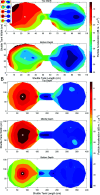Conditioning invasive bigheaded carps (Hypophthalmichthys molitrix and H. nobilis)to enhance the efficacy of acoustic and CO2 deterrents
- PMID: 40388395
- PMCID: PMC12088057
- DOI: 10.1371/journal.pone.0320395
Conditioning invasive bigheaded carps (Hypophthalmichthys molitrix and H. nobilis)to enhance the efficacy of acoustic and CO2 deterrents
Abstract
Invasive bigheaded carps (Hypophthalmichthys molitrix and H. nobilis) have caused substantial ecological and economic damage throughout the Mississippi River Basin and expanded their range threatening the Laurentian Great Lakes. Broadband acoustic deterrents have shown promise in repelling carp and are currently being assessed in navigational lock chambers on the Mississippi River. These nonphysical deterrents permit vessel navigation while reducing carp passage. However, no single deterrent is 100% effective and fish may habituate to the sound after repeated playback. Carp exhibit aversive behaviors to carbon dioxide, which suggests combining these two stimuli into one deterrent system could extend the effective duration of sound and reduce the frequency of carbon dioxide ([Formula: see text]) application. We conditioned bigheaded carps to associate broadband sound from outboard boat motors (0.06-5 kHz, [Formula: see text]150 dB re. 1 [Formula: see text]Pa) with [Formula: see text] application ([Formula: see text]35,000 ppm) in small (80 L) and large (3475 L) two-choice shuttle tanks. We compared negative phonotaxis responses over one to four weeks between fish conditioned with sound and [Formula: see text], sound and air, or sound alone. Similar [Formula: see text] avoidance thresholds were found across tank sizes and species. Conditioning treatment did not affect time to leave the sound chamber, confirming sound alone remains a deterrent for all fish. Carp conditioned with [Formula: see text] took longer to return to the sound chamber than control treatments. Control fish were closer to the speaker during playback than during the pre-sound period, while fish conditioned with [Formula: see text] were not significantly closer. Conditioning paradigms may extend the effective duration of nonphysical deterrents for bigheaded carps. Conditioning with [Formula: see text] may also increase proactive flight-responses over reactive freeze-responses. Findings could be applied to increase nonphysical barrier effectiveness at locks along the Mississippi River and help protect the Laurentian Great Lakes from invasion.
Copyright: © 2025 Culotta et al. This is an open access article distributed under the terms of the Creative Commons Attribution License, which permits unrestricted use, distribution, and reproduction in any medium, provided the original author and source are credited.
Conflict of interest statement
The authors have declared that no competing interests exist.
Figures











References
-
- Kolar CS, Chapman DC, Courtenay WR, Jr, Housel CM, Williams JD, Jennings DP. Bigheaded carps: a biological synopsis and environmental risk assessment. Am Fish Soc Spec Publ. 2007;33:i–xiv, 1–204. doi: 10.47886/9781888569797 - DOI
-
- Noatch MR, Suski CD. Non-physical barriers to deter fish movements. Environ Rev. 2012;20(1):71–82. doi: 10.1139/a2012-001 - DOI
-
- Cudmore B, Mandrak NE, Dettmers JM, Chapman DC, Kolar CS. Binational ecological risk assessment of bigheaded carps (Hypophthalmichthys spp.) for the Great Lakes Basin. Report. Ottawa, ON; 2012. Report No.: 2011/114.
-
- Putland RL, Mensinger AF. Acoustic deterrents to manage fish populations. Rev Fish Biol Fisheries. 2019;29:789–807. doi: 10.1007/s11160-019-09583-x - DOI
-
- Riesgraf AT, Finger JS, Zielinski DP, Dennis CE, Whitty JM, Sorensen PW. Evaluation of a broadband sound projected from the gates of a navigation lock in the Mississippi River shows it to be a weak deterrent for common carp and unable to block passage. Manage Biol Invasions. 2022;13(1):220–32.
MeSH terms
Substances
LinkOut - more resources
Full Text Sources
Research Materials
Miscellaneous

